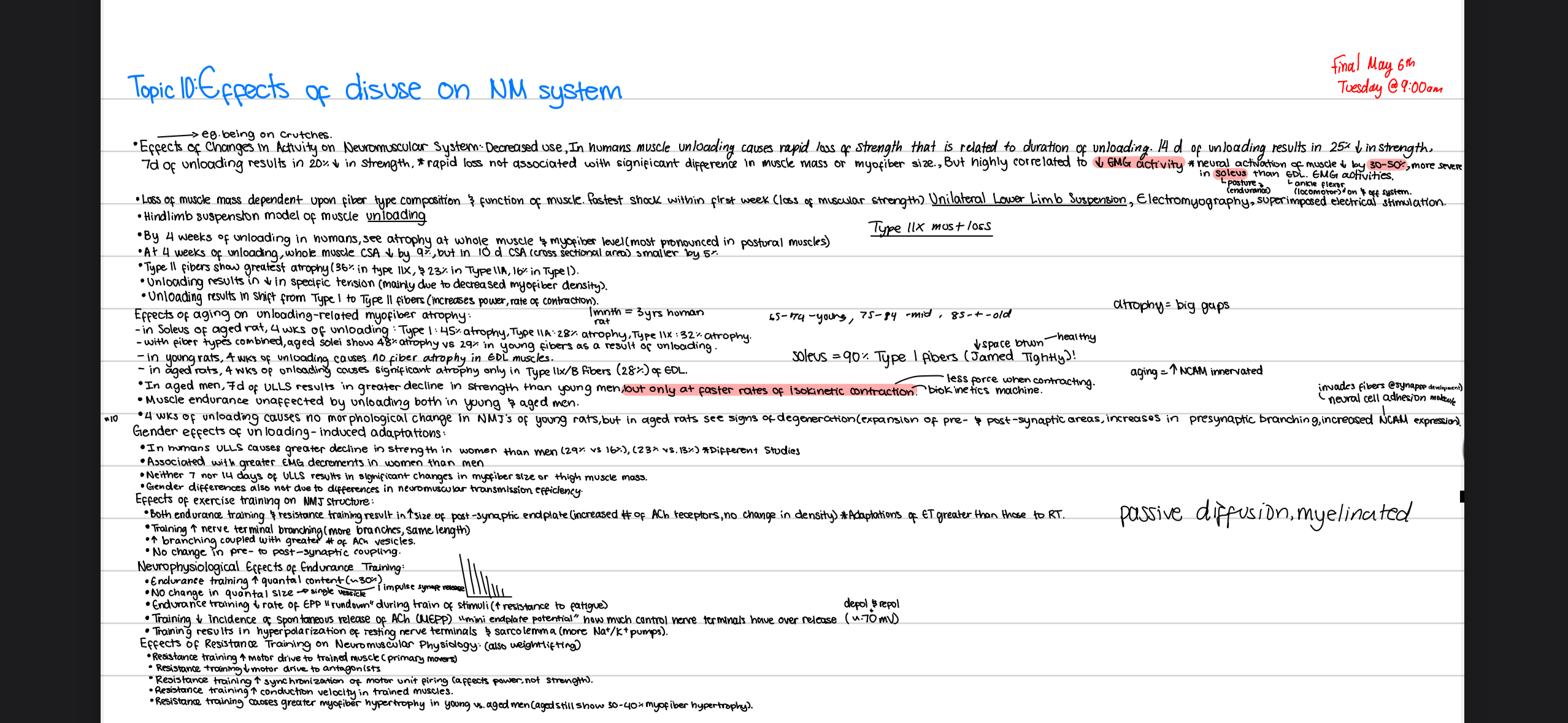topic 10

Topic 10: Effects of disuse on NM system
→ e.g., being on crutches.
Effects of Changes in Activity on Neuromuscular System: Decreased use.
In humans, muscle unloading causes rapid loss of strength that is related to duration of unloading.
14 d of unloading results in 25% ↓ in strength, 7d of unloading results in 20% ↓ in strength
*rapid loss not associated with significant difference in muscle mass or myofiber size, but highly correlated to ↓ EMG activity + neural activation of muscle ↓ by 30–50%
more severe in soleus than EDL EMG activities.
→ Posture, extensor fibers (condensed) vs locomotors (ankle flexor)
Loss of muscle mass dependent upon fiber type composition & function of muscle.
Fastest shock within first week (loss of muscular strength)
unilateral lower limb suspension, electromyography, superimposed electrical stimulation
Hindlimb suspension model used to mimic unloading
By 4 weeks of unloading in humans, see atrophy at whole muscle & myofiber level (most pronounced in postural muscles)
At 4 weeks of unloading, whole muscle CSA ↓ by 9%, but in 10d CSA (cross-sectional area) smaller by 5%
→ Type II fibers show greatest atrophy (36% in type IIx, 23% in Type IIa, 11% in Type I)
→ Unloading results in ↓ in specific tension (mainly due to decreased myofiber density)
→ Unloading results in shift from Type I to Type II fibers (increases power, rate of contraction)
**The type of fiber (in terms of function) is shifting toward fast-twitch.
But those fibers are also the ones most prone to atrophy (shrinking) during unloading.
Effects of aging on unloading-related myofiber atrophy:
In soleus of aged rats, 4 wks of unloading
Type I: 45% atrophy, Type IIa: 28% atrophy, Type IIx: 32% atrophy.
With fiber types combined, aged soleus show 48% atrophy vs 29% in young fibers as a result of unloading.
In young rats, 4 wks of unloading causes NO fiber atrophy in EDL muscles.
In aged rats, 4 wks of unloading causes significant atrophy only in Type IIb/X fibers (28%) of EDL.
In aged men, 7d of ULLS results in greater decline in strength than young men, but only at faster rates of isokinetic contraction.
Isokinetic = contraction at a constant speed (velocity), typically measured with a machine like a dynamometer.
Faster isokinetic contractions = contractions at high movement speeds (e.g., kicking out the leg quickly).
older men show a greater drop in strength specifically at higher movement speeds.
Muscle endurance unaffected by unloading both in young & aged men.
4 wks of unloading causes no morphological change in NMJ’s of young rats, but in aged rats see signs of degeneration (expansion of pre- & post-synaptic areas, increases in presynaptic branching, increased NCAM expression).
NCAM = neural cell adhesion molecule
High levels of NCAM are often seen during development, regeneration, or denervation
So ↑ NCAM suggests the NMJ is undergoing stress or attempting to repair or reinnervate muscle fibers
Gender effects of unloading - induced adaptations:
In humans, ULLS causes greater decline in strength in women than men (29% vs. 16%), (23% vs. 13%) *Different Studies
Associated with greater EMG decreases in women than men
neither 7 nor 14 days of ULLS results in significant changes in myofiber size or thigh muscle mass
Gender differences also not due to differences in neuromuscular transmission efficiency
Effects of exercise training on NMJ structure:
Both endurance training & resistance training result in ↑ size at post-synaptic endplate (increased # of ACh receptors, no change in density) *adaptations of endurence training greater than those to resistance training
Training increases nerve terminal branching (more branches, same length)
The nerve terminal is the part of the motor neuron that connects to the muscle.
Still one nerve per fiber
But that one nerve’s terminal is more branched and complex
↑ branching associated with greater # of ACh vesicles
No change in pre- or post-synaptic coupling
Coupling refers to the alignment and communication efficiency between the nerve terminal and the muscle membrane.
Neurophysiological Effects of Endurance Training:
Endurance training ↑ quantal content (~30%)
Quantal content = the number of vesicles of acetylcholine (ACh) released per nerve impulse.
No change in quantal size → single vesicle
Quantal size = the amount of ACh per vesicle
Endurance training decreases rate of EPP “rundown” during train of stimuli (increased resistance to fatigue)
When a nerve fires rapidly (a "train of stimuli"), the EPP (endplate potential) can weaken over time — this is called rundown.
Endurance training reduces this effect, meaning EPP stays stronger for longer, even with repeated use.
Training ↓ incidence of spontaneous release of ACh (MEPP) mini endplate potential → have much control nerve terminals have over release -70mV
MEPPs (Miniature Endplate Potentials) = tiny, random releases of ACh that happen without stimulation.
Training results in hyperpolarization of resting nerve terminals & sarcolemma (more Na⁺/K⁺ pump)
Hyperpolarized cells are less likely to fire spontaneously.
Effects of Resistance Training on Neuromuscular Physiology (also weight lifting):
Resistance training ↑ motor drive to trained muscle (primary movers)
Resistance training ↓ motor drive to antagonist
Resistance training ↑ synchronization in motor unit firing (affects power, not strength)
Resistance training ↑ conduction velocity in trained muscles
Resistance training causes greater myofiber hypertrophy in young vs. aged men (aged still show 30–40% myofiber hypertrophy)